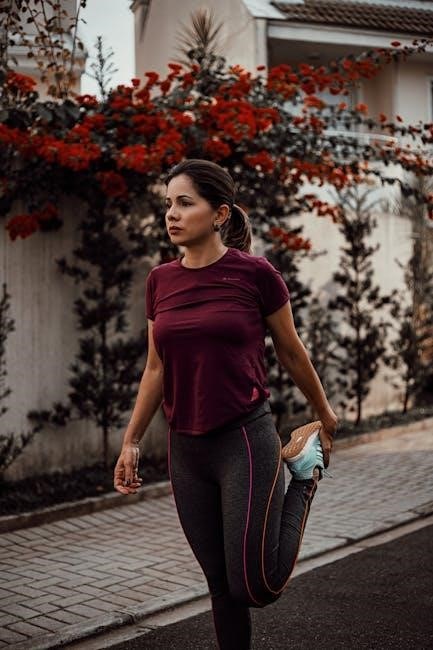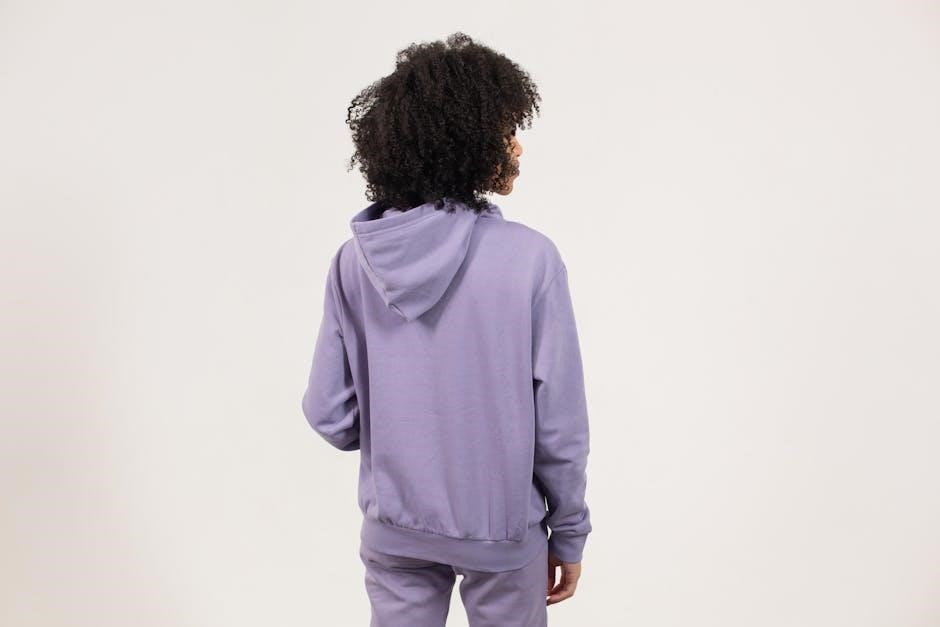Discover the ultimate guide to finding women’s dress pants that combine style, comfort, and perfect fit. Learn how to choose pants that flatter your body and meet your lifestyle needs, ensuring confidence and elegance in every outfit.
1.1 Importance of Proper Fit
A proper fit in women’s dress pants is essential for both comfort and confidence. Ill-fitting pants can restrict movement, create discomfort, and detract from your professional or stylish appearance. A well-fitted pair enhances your silhouette, ensures all-day wearability, and boosts self-assurance. Whether for work or casual events, the right fit guarantees a polished look and a flattering drape, making it a cornerstone of a versatile wardrobe.
1.2 Purpose of the Guide
This guide aims to empower women to find the perfect fit in dress pants, offering expert advice on measurements, styles, and body types. By addressing common fit issues and providing practical tips, it helps you make informed choices, ensuring your pants are both comfortable and flattering. Whether you’re shopping online or in-store, this guide equips you with the knowledge to select pants that enhance your confidence and personal style effortlessly.
Key Components of Fit
The key components of fit include waist and rise, seat and crotch, leg width and length, and fabric. Each plays a role in comfort and style.
2.1 Waist and Rise
The waist and rise are critical for a comfortable and flattering fit. Pants should sit at your natural waist or hip, depending on the style. The waistband should allow no more than two fingers to fit comfortably. The rise, or distance from the crotch to the waistband, should be proportional to your body. A proper fit ensures the pants stay in place without digging or sagging, balancing comfort and style effectively.
2.2 Seat and Crotch
The seat should fit smoothly, neither too tight nor too loose, with fabric that drapes naturally over your curves. The crotch height should feel comfortable, avoiding excessive tightness or sagging. A well-fitted seat and crotch ensure freedom of movement and prevent unsightly pulling or gaping. Proper fit in this area is essential for both style and comfort, making it a key focus in choosing the right dress pants.
2.3 Leg Width and Length
Leg width determines the pant’s silhouette, ranging from slim to wide. The length should break slightly above the shoe for a polished look. Proper leg width ensures comfort, while accurate length prevents dragging or an overly short appearance. Balancing these elements creates a flattering, proportional fit that complements your body and personal style, ensuring both aesthetic appeal and practicality in your choice of dress pants.
2.4 Fabric and Stretch
Fabric choice significantly impacts comfort and fit. Stretch fabrics, like those with spandex or elastane, offer flexibility and shape retention. They provide a comfortable fit without sacrificing structure. For active lifestyles, high-stretch fabrics are ideal, while minimal stretch fabrics suit formal settings. Opting for breathable materials ensures all-day comfort. Consider your lifestyle and preferences when selecting fabric to ensure the perfect balance of style, comfort, and durability in your dress pants.

How to Measure Yourself Accurately
Use a flexible tape measure to take precise measurements around your natural waistline, hips, and inseam. Ensure the tape is snug but not tight for accurate results.
3.1 Essential Measurements
Accurate measurements are crucial for the perfect fit. Measure your natural waistline, standing straight, keeping the tape snug but not tight. Next, measure your hips, typically 7-9 inches below the waistline. Measure the inseam by placing the tape along the inside of your leg from the crotch to the desired pant length. For added accuracy, measure your thigh circumference to ensure a comfortable fit.
3.2 Tools Needed
To ensure accurate measurements, you’ll need a flexible tape measure, a full-length mirror, and a pair of well-fitting pants for comparison. Use a calculator to interpret measurements and determine your size. Additionally, a stretch fabric gauge can help assess fabric elasticity, ensuring comfort and flexibility in your dress pants. These tools will guide you in selecting pants that align with your body type and lifestyle needs for the perfect fit.
Understanding Your Body Type
Understanding your body type—pear-shaped, hourglass, athletic, or petite—is crucial for selecting dress pants that flatter your figure and ensure a comfortable, stylish fit.
4.1 Common Body Types
Common body types include pear-shaped, hourglass, rectangular, and triangular. Pear-shaped women carry weight in hips and thighs, while hourglass figures have balanced proportions. Rectangular body types have similar measurements throughout, and triangular types have narrower waists. Understanding these shapes helps determine which dress pants styles will flatter your silhouette, ensuring a comfortable and stylish fit.
4.2 Recommended Styles
Pear-shaped women look best in tailored trousers that balance their silhouette. Hourglass figures are flattered by high-waisted styles that accentuate their curves. Rectangular body types can opt for slim or straight-leg pants for a streamlined look. Triangular shapes benefit from A-line or wide-leg styles that add balance. These recommendations ensure a flattering fit for each body type, enhancing both style and comfort.

The Fit Through the Waist and Rise
A well-fitted waistband should sit comfortably, allowing two fingers to fit easily. Pants should neither sag nor dig into the skin, ensuring a balanced look and optimal comfort.
5.1 How Pants Should Sit
Well-fitted pants should sit smoothly on the hips or waist, depending on the style. They should neither sag nor feel restrictive, with a waistband that stays in place without digging. The rise should complement your torso, ensuring a balanced look. Proper sitting prevents discomfort and ensures a polished appearance, whether for work or casual events, making you feel confident and put-together all day long.
5.2 Adjustments for Comfort
For optimal comfort, ensure the waistband allows up to two fingers to fit snugly. If the waist feels too tight, consider a larger size or stretch fabric. Conversely, if the waist is loose, a belt can provide support. Adjustments like darts or pleats can enhance fit, while stretch fabrics offer flexibility. These tweaks ensure a balance of comfort and style, making your pants wearable all day without compromise.

Achieving the Perfect Seat and Crotch Fit
Achieving the perfect seat and crotch fit ensures both comfort and a polished look. The fabric should drape smoothly without wrinkles or sagging. Avoid pants that gap at the back or dig into the thighs. A well-fitted crotch should sit naturally, neither too tight nor too low. Stretch fabrics can enhance comfort while maintaining a tailored appearance, ensuring a flattering and functional fit for any body type or lifestyle.

How to Choose the Right Leg Width and Length
Choosing the right leg width and length balances style and comfort. Slim legs create a streamlined look, while wider legs offer a relaxed fit. Ensure the length complements your height—petite, regular, or tall. The hem should graze your shoes for a polished appearance. Pairing the leg width with your body type and lifestyle ensures a flattering, functional fit that enhances your overall look and comfort throughout the day.
The Role of Fabric and Stretch in Fit
Fabric and stretch are key to comfort and style. Stretch fabrics like spandex or elastane offer flexibility, making slim-fit pants comfortable without restriction. Wool, cotton, or polyester blends provide structure and durability. The right fabric ensures mobility, breathability, and a flattering fit. For active lifestyles, high-stretch materials are ideal, while structured fabrics suit formal settings. Balancing fabric choice with your needs ensures optimal comfort and style in your dress pants.

Common Fit Issues and How to Solve Them
Address issues like waistbands that are too tight or loose, seat gaps, and pant length problems. Adjustments and fabric choices can ensure a comfortable, flattering fit.
9.1 Waist Too Tight or Loose
A waistband that’s too tight can cause discomfort, while one that’s too loose may not stay in place. Ensure no more than two fingers fit between the waistband and your body. For a tight waist, consider stretch fabrics or adjustable waistbands. If the waist is loose, try a belt or opt for pants with a contour waistband for a more tailored fit.
9.2 Seat and Thigh Gaps
Seat and thigh gaps in women’s dress pants can affect both comfort and appearance. If the pants are too tight, they may cause discomfort and visible lines. If too loose, they can create an unflattering baggy look. To address this, opt for stretch fabrics or tailored styles that skim your body. Adjusting the rise or trying different cuts, like high-waisted or mid-rise, can also help achieve a smoother, gap-free fit.
9.3 Pant Length Issues
Pant length issues can impact both style and practicality. If pants are too long, they may bunch up unattractively around the ankles. If too short, they can appear ill-fitting. To resolve this, consider petite or tall sizing options or hemming. Ensure the length aligns with your shoe style, as this affects the overall look. Proper pant length enhances proportions and ensures a polished, professional appearance.

Step-by-Step Guide to Choosing the Right Pants
Start with precise measurements, consider your lifestyle needs, and try pants before purchasing. Ensure the fit flatters your body type for ultimate comfort and style confidence.
10.1 Start with Measurements
Begin by taking precise measurements to ensure the best fit. Measure your natural waistline, hips (7-9 inches below the waist), and thighs (around the widest part). Note your inseam (from crotch to ankle) and rise preference (low, mid, or high). Use a flexible tape measure and ensure the fit isn’t too tight or loose. Accurate measurements are the foundation for selecting pants that flatter your silhouette and provide comfort all day long.
10.2 Consider Lifestyle Needs
Think about how you’ll wear the pants and your daily activities. For office settings, opt for structured fabrics and classic styles. If you’re active, choose stretchy, breathable materials for comfort. Consider the dress code and your personal preferences, such as trendy details or timeless designs. Ensure the pants align with your lifestyle to maximize versatility and satisfaction in your wardrobe choice.
10;3 Try Before You Buy
Always try on dress pants before purchasing to ensure the best fit. Check the waistband, seat, and leg width while sitting and standing. Pay attention to comfort and mobility. If shopping online, opt for brands with easy return policies. This step ensures the pants meet your comfort and style expectations, avoiding costly mistakes and wasted time.
Choosing the perfect women’s dress pants involves understanding your measurements, body type, and lifestyle needs. Prioritize comfort, quality, and a flattering fit. Experiment with styles, and don’t hesitate to try before buying. Invest in stretch fabrics for ease of movement and a tailored look. Remember, confidence shines through when you wear pants that fit and feel right. Happy shopping!